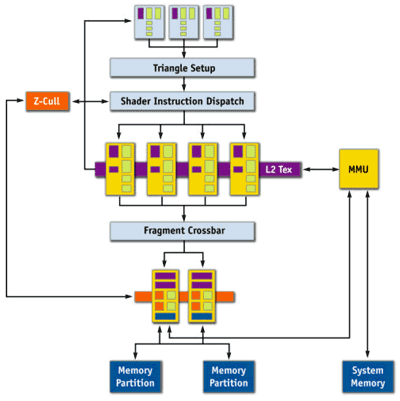What sets the GeForce 6200 with Turbo Cache apart
from other videocards its ability to use system memory as a dynamic
"local" frame buffer. The NX6200TC-TD32E test sample uses 32MB of onboard memory while the rest
of the data is placed into up to 96MB of dynamically reserved system memory. This
is possible through the new MMU (Memory Management Unit) that allows the GPU
to read and write data to the PC's main memory.

Along with the Forceware drivers, the
TurboCache Manager (TCM for short) is able to place colour, texture and Z-Buffer
data in system memory. The TCM dynamically adjusts how much system memory is
reserved for videocard use based on demand;
once the game or 3D application has been closed, RAM allocated to the videocard is once
again available to the rest of the system. This means that unlike integrated video
cards that snatch a certain amount of system memory, a GeForce 6200 TC videocard does
not permanently slow down the system. Note that nVIDIA recommends at least 512MB of system memory
be installed, which could be a factor in the 6200 TC's adoption as an
entry level video chipset.
The biggest "pro" for nVIDIA and its accompanying manufacturers is
that TurboCache reduces the need for memory on the actual
videocard, saving on costs.

If you'd like to read up more on Turbo Cache, nVIDIA has a great PDF on its technology
right here.
 |
| Overclocking Results: |
|
stock |
overclocked |
|
| gpu (core)
speed: |
350MHz |
428MHz |
| Memory
Speed: |
700MHz |
829MHz | |
Considering the NX6200TC-TD32E is a entry level solution,
I didn't have high hopes in terms of overclocking. Starting with the core
which is clocked at 350 MHz by default, we raised it only a few MHz at a time.
It seems like the GeForce 6200 GPU is up to the overclocking challenge and we were
able to push the card as high as 428 MHz before RivaTuner complained about the
core not passing its test.
The memory is clocked at 700 MHz by default and it
turned out to be a pretty good overclocker too, hitting 829
MHz!
 |
| PCStats Test System Specs: |
| processor: |
amd athlon64 4000+ |
| clock
speed: |
12 x 200 mhz = 2.4 ghz |
| motherboards: |
dfi lanparty nf4 sli-dr (nf4-sli)
gigabyte ga-k8nsnxp-939 (nf3
ultra) |
| videocard: |
msi rx800xt-vtd256e
ati radeon x800 xl
gigabyte
gv-rx80l256v
powercolor x700 pro
powercolor bravo x700
msi
nx6800gt-t2d256e
albatron trinity geforce 6600gt agp
msi
nx6600gt-td128
albatron trinity pc6600
asus extreme
n6600top/td/128m/a
gigabyte gv-3d1 (single mode)
gigabyte
gv-3d1 (sli mode)
msi nx6600gt-td128e (single mode)
msi
nx6600gt-td128e (sli mode)
msi nx6200tc-td32e |
| memory: |
2x 512mb mushkin pc3200 l2 v2 |
| hard drive:
|
74gb wd raptor 10k rpm sata hdd |
| cdrom: |
aopen 52x combo |
| powersupply: |
seasonic super tornado 400w |
| software
setup |
windowsxp build 2600
nforce
catalyst 4.12
detonator
66.93 |
| benchmarks |
3dmark2001se
3dmark05
codecreatures
aquamark
gun
metal 2
x2 the threat
ut2003
doom3 | |
the agp and pci-e systems use a different
motherboard but results are shown for reference.
